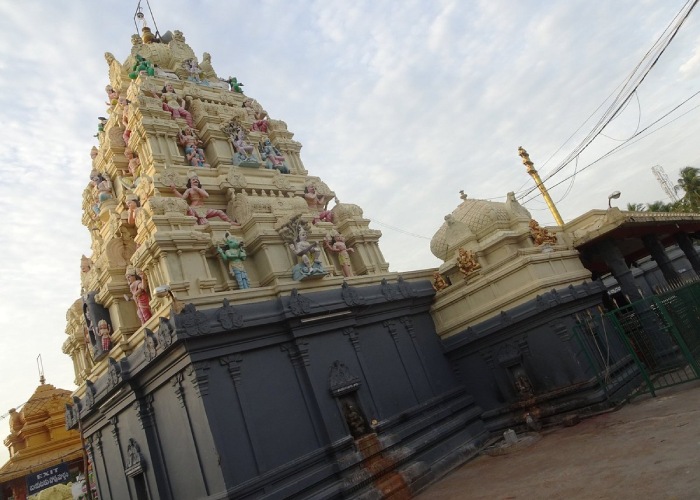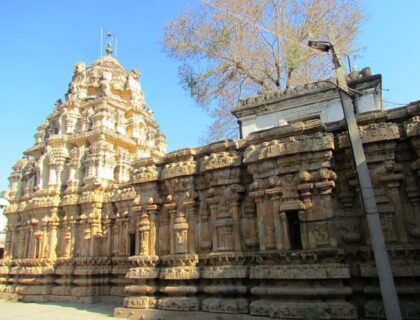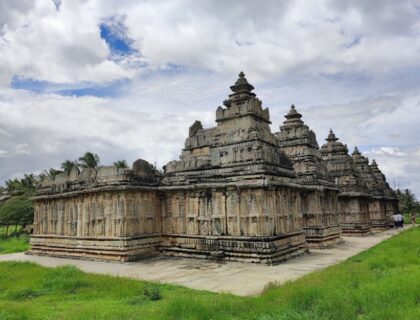Kukkuteswara Temple Pithapuram
The Kukkuteswara Temple also known as Pithapuram is an ancient Hindu temple located in Pitapuram, Kakinada district, Andhra Pradesh, India. The temple is significant in both the Saivite and the Shakta Hindu traditions. It is one of the eighteen Maha Sakthi Peethas, which are considered the most important pilgrimage sites in Shaktism. The temple’s presiding deity is Lord Kukkuteswara, a rooster-like form of Lord Siva, and his consort Rajarajeswari Devi.
Puruhutika Devi Temple, one of the Maha Shakti Peethas, is located on the premises of Kukkuteswara Temple. Pithapuram is mentioned in the Skanda Purana, in Srinatha’s Bheemeswara Puranamu, and on a stone pillar in Allahabad by Samudragupta. Kukuteswara Swamy is a Spatika Lingam Swayambhu. The temple is also well-known for its one-stone Nandi.
Story Behind Kukkuteswara Temple Pithapuram
According to legend, the demon Gayasura was a devout devotee of Lord Vishnu who did penance for years. Lord Vishnu appeared before him and granted his wish that anyone who sees him achieve Moksha. Gayasura used his spiritual powers to enlarge his body so that everyone on Earth could be saved. The God of Heaven, Indra, and the Devas expressed concern to the three deities about the creation’s imbalance. Lord Vishnu, Brahma, and Siva disguised themselves as Brahmins and approached Gayasura in search of Yajna space.
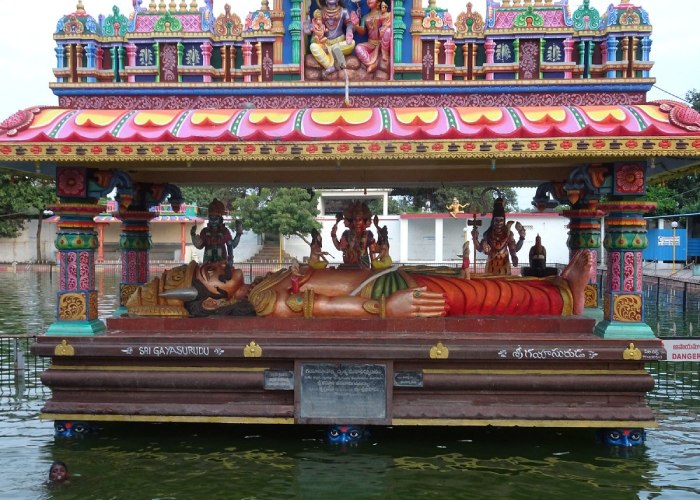
The Brahmins explained that there are many evil spirits on Earth, so they want to perform Yajna on Gayasura’s sacred body. Brahmins then asked him to lie down on the Earth for 7 days without moving so that Yajna could be performed peacefully. Any deviation from the specified conditions will result in death. Gayasura agreed to the terms and settled on Earth. He grew his body to the point where his head lay in Siro Gaya in Bihar, his navel in Nabi Gaya in Orissa, and his legs in Pada Gaya in Pithapuram. Gayasura counts each one by listening to the cock crowing early in the morning.
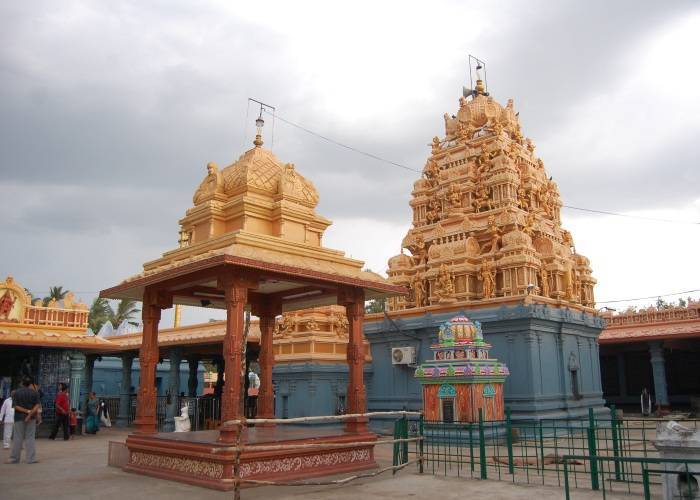
Lord Shiva transformed himself into a cock and Crowed at midnight on the last day of the Yajna. Gayasura got up to listen to the sound, which disturbed Yajna. Angry Brahmins yelled at Gayasura, “If you can’t keep your promise for 7 days, how can you take on the sins of all humanity?” Gayasura was ready to sacrifice because he had met the requirements. Lord Vishnu, Brahma, and Siva appeared before him in their true forms and granted his wish that the place where he lay down be a sacred place with Lord Vishnu at the head, Lord Brahma at the Nabi, and Lord Siva at the feet.

Skanda Purana mentions Sage Vyasa, Pandavas, and Kunti visited this place in Dwapara yuga. During the Tretayuga period, Lord Rama paid a visit to this place. During the Krutayuga period, Lord Vishnu, Brahma, and Indra visited this place.
History related to Kukkuteswara Temple Pithapuram
This location is one of the Trigaya Kshetrams and is known as Pada Gaya Kshetram. Gaya Asura was a powerful demon who laid down his life at the request of Brahma to perform a great yagna for the betterment of people. He was so massive that his head was in Bihar and his legs were in Pithapuram. The pond where his legs rested became known as Pada Gaya Sarovar after he rested there. Anyone who bathes in this sacred pond is said to be cleansed of their sins.

Pithapuram, like ‘Kedaram’ in northern India and ‘Kumbhakonam’ in southern India, is a sacred and holy place. This location was visited by the sage Vyasa and his disciples and is mentioned in the Skanda Purana’s Bhimakhanda, one of the eighteen epics.

The great poet “Srinadha” wrote in the third chapter of the “Bheemeswara Purana” as follows. (Banaras), Varanasi, Kedaram, Kumbhakonam, and Pithapuram (Kukkuteswara Stanamu) are the next four places that provide salvation or “Moksha.” Pithapuram evolved into Paadagaya Keshetram.
Architecture of Kukkuteswara Temple Pithapuram
The Kukkuteswara Temple was built in the Dravidian style, with sculptures on the gopuram and the vimana above the sanctum. The temple is large and open. Near the temple pond is a massive statue of Gayasura in a lying pose with the Trimurthis, depicting the temple’s legend. The walls of the Puruhutika Devi shrine were carved with Ashtadesa Shaktipeeths.

Devi’s idol has four hands. Around the temple, there are shrines to Vinayaka, Subrahmanya Swamny, Kalabhaoirava, Annapoorneshwari, Sri Rama, and other deities. Shiva’s Lingam is a swayambhu in the form of a cock. A massive Nandi statue can be found here. The Dattatreya temple is also located within the premises. The temple contains an imprint of Vishnu’s footprints.

The Kunti Madhavaswamy temple is another major temple in the complex, which is located next to the Kukkuteswara temple. Kunti is said to have installed the image in this location and is thus known as Kunti Madhavaswamy. Vyasa, Valmiki, and Agastya are said to have worshipped this deity in the past. The Temple Complex also contains Swayambhu Sri Dattatreya Swamy.
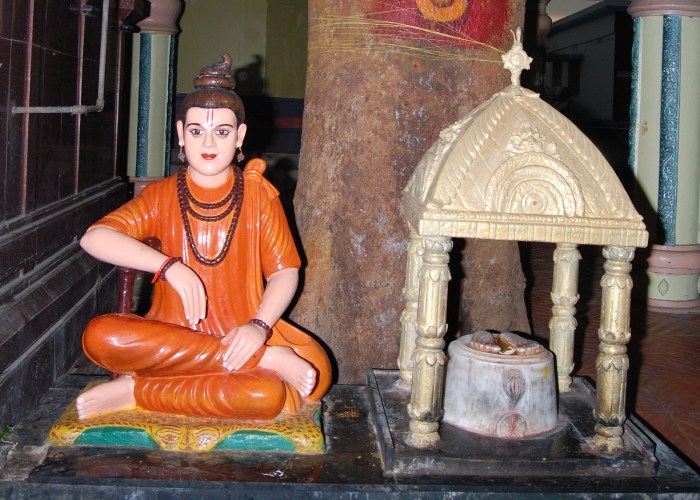
The idol of Sripada Srivallabha Swamy is worshipped separately in the same complex. It is the sole location where an idol of Sri Datta’s incarnation is worshipped. Other gods’ shrines include Sri Rama, Ayyappa, Sri Vishveshwara, and Sri Annapurna Devi, as well as Sri Durga Devi.
Facts about Kukkuteswara Temple Pithapuram
- Kukkuteswara Temple Pithapuram in Andhra Pradesh became famous as Padagaya. Lord Shiva in the form of Cock is the primary deity of this temple. The Shakti Peetham is known by Puruhutika.
- Srinadha, the great poet, wrote in the third chapter of Bheemeswara Purana as follows. Varanasi (Banaras), Kedaram, Kumbhakonam, and Pithapuram, known as Padagaya Kshetram, are the four places that provide salvation or Moksha.
- In front of the temple is a massive, beautiful Nandi idol carved from a single stone.
- Puruhutika Devi Temple is also located within the campus of Sri Kukkuteswara Swamy Temple and is one of the Asta Dasha Shakti Peethas.
- Goddess Sati Devi’s body part fell in this area after Daksha Yagna because this place was previously known as Puruhoothika Puram and was later renamed Pithapuram.
- This temple is the 10th Sakthi Peetham of the 18 Shakti Peethas, and it celebrates festivals such as Maha Shivaratri, Sarannavarathri, Navratri, and Kartika Masam.
- Pithapuram is well-known for its historic temples. Pithapuram is one of the twelve holy pilgrim centres (punya kshetram) and is regarded as the equivalent of Kasi.
Best Time To Visit Kukkuteswara Temple Pithapuram
This place is heavenly and spiritual; you can visit it all year. However, the best time to visit this temple is during the monsoon and winter seasons. During the monsoon season, this location receives moderate to heavy rainfall, making it appear heavenly with its greenery and bringing freshness elsewhere.
Famous Festivals In Kukkuteswara Temple Pithapuram
Millions of people visit this temple every year to celebrate all of the festivals that are held here. Some major festivals held here are
- Durga Puja. (Winter) – Devotees celebrate Navaratri at this temple in Ashwin (Sep-Oct).
- Navaratri. (Summer) – They celebrate other Navaratri in the fortnight of the Chaitra (March-April). Every nine days they worship Navadurga (nine Durgas).
- Shravan Month – This month is considered the holiest month for lord Shiva devotees.
- MahaShivratri – Mahashivratri, “The Great Night of Shiva” is the most significant event in the Indian Hindu calendar. Shiv Khori’s cave temple is packed with activity during its three-day Mela (festival) held during Maha Shivratri (February-March). Thousands of Lord’s devotees attend the festival.
How To reach Kukkuteswara Temple Pithapuram
Shri Kukkuteswara Temple is a Lord Shiva Temple located in the East Godavari District of Andhra Pradesh.
By Air: The closest airport to the Shiv Khori temple is Vijayawada Airport which is 142 km and Rajahmundry Airport is 56 km from the Kukkuteswara Temple.
By Railway: The nearest railway station is Pithapuram Railway Station which is 1.7 km from the Kukkuteswara Temple.
By Roadways: The nearest bus station is Pithapuram Bus Station which is 1 km from the Kukkuteswara Temple.
Also, Read – Vishnupad Temple Gaya
Support Us
If our content helps you even 1% in gaining information about the temple, please support us by contributing any amount, our UPI ID is - q417999792@ybl Or pay using QR CODE >>> Click Now
Location
Facilities
- Drinking Water
- Pooja Item Shops
- Prasad Shops
- Restaurants Nearby
- Resting Room




